Pretty much everyone with an interest in astronomy has used a pair of binoculars: whether to scan the Milky Way, track down a comet or follow the fluctuations of variable stars.
We all know what a joy they are, but their simplicity does come with a price attached.
After 10 minutes of holding up a pair of 10x50s – far sooner with 20x80s – they begin to feel so heavy it’s difficult to hold them steady.
Worse still, if you observe the portion of the sky high overhead from a standing position, you may well end up with a crick in the neck.
Manufacturers have applied their ingenuity to these issues and have come up with many different types of binocular mount.F
For more advice, read our guide to the best binoculars for astronomy and the best budget binoculars.

Advantages of using a binocular mount
A good binocular mount and tripod will ease the load on your arms and neck, and keep your binoculars steady so you can see those fainter stars, but of course they do vary in sophistication, effectiveness and price.
At one end of the scale, you have simple tripods with a built-in altazimuth mount.
More expensive setups feature independent mounts and tripods, which you can buy separately or as a package.
And, at the highest end of the scale, there are parallelogram mounts.
These have the advantage of allowing you to adjust the height of the mount while staying fixed on the same object – making them ideal for use in a group situation where observers have different heights.
The trouble is, they are bulky and costly.
What kind of binocular mount and tripod you choose will vary according to what binoculars you’re using, what you’re using them for and, of course, your budget.
That’s why we’ve put a selection of different models through their paces.
Read our DIY Astronomy guides on how to hold your binoculars steady and how to make a binocular mirror mount.
How to choose a binocular mount and tripod
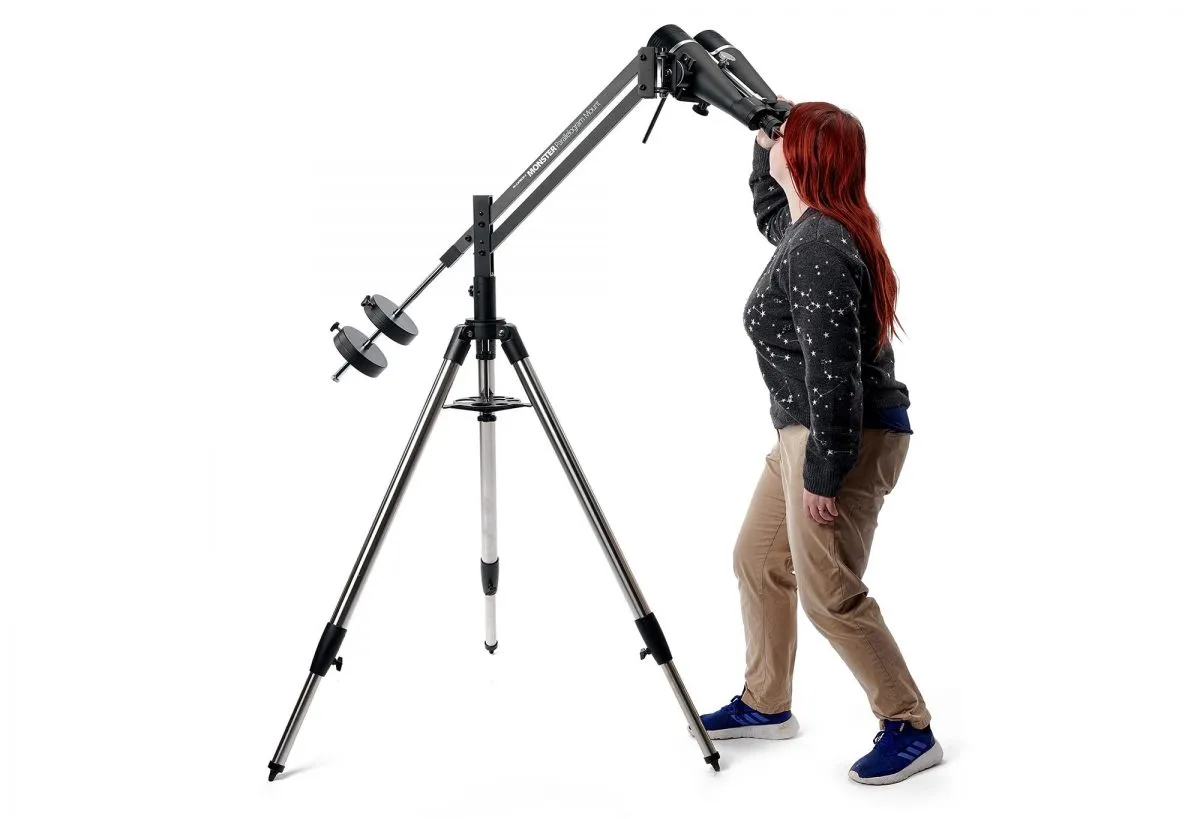
To test a binocular mount and tripod and decide whether it's for you, first look at the build quality, then, if you get a chance to test it in the field, check its impact when used in practice.
The comfort of viewing when standing up, sitting down and lying on a garden recliner is also important.
One of the great pleasures of binoculars is their convenience of use: you point them and the fun starts.
If the mount makes things a lot more complicated, then some of the reason for using binoculars is lost.
So a mount requiring a lot of mucking about should be avoided at all costs.
Finally, look at whether the solutions provided by your binocular telescope and mount are expensive for the benefits they offer.
Would a low focal ratio refractor seem a viable alternative?
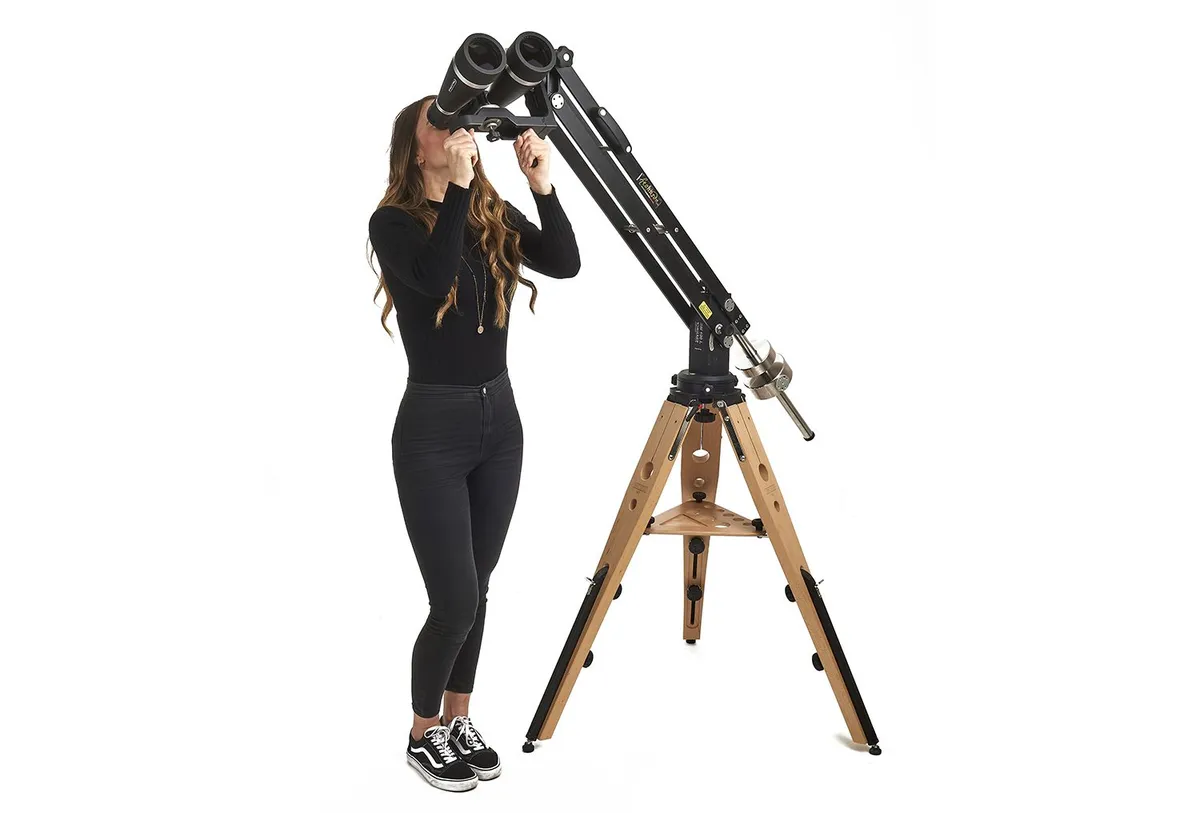
Binocular mounts and tripods: 5 things to consider
Mount capacity
Good binoculars are expensive. You really don’t want them falling off the mount and breaking. There’s a lot of difference in weight and size between a pair of 7x40s and 20x80s – can the mount cope with all the possibilities? Similarly, does the mount ‘droop’ when you set a given elevation?
Movement
When you sweep across the sky the movement should be smooth, while remaining firm enough that simply touching the binoculars or mount does not bounce an object out of the field of view.
Height adjustment
It must be easy to adjust the tripod so that the binoculars are at a level that comfortably accommodates your particular height. Are lots of adjustments needed and how easily is adjustment accomplished?
Tripod construction
Is the tripod light enough to easily carry to the observing site? Will it provide a platform that is rigid, and easy to assemble and adjust? Do all the adjustment knobs operate smoothly and are they readily accessible – even in the dark?
Feet
The feet of a tripod are essential for making it stable, and so unlikely to move if it’s accidentally kicked in the dark. Will they work well on different surfaces such as concrete and grass?
9 best binocular mounts and tripods
Horizon Heavy Duty Tripod
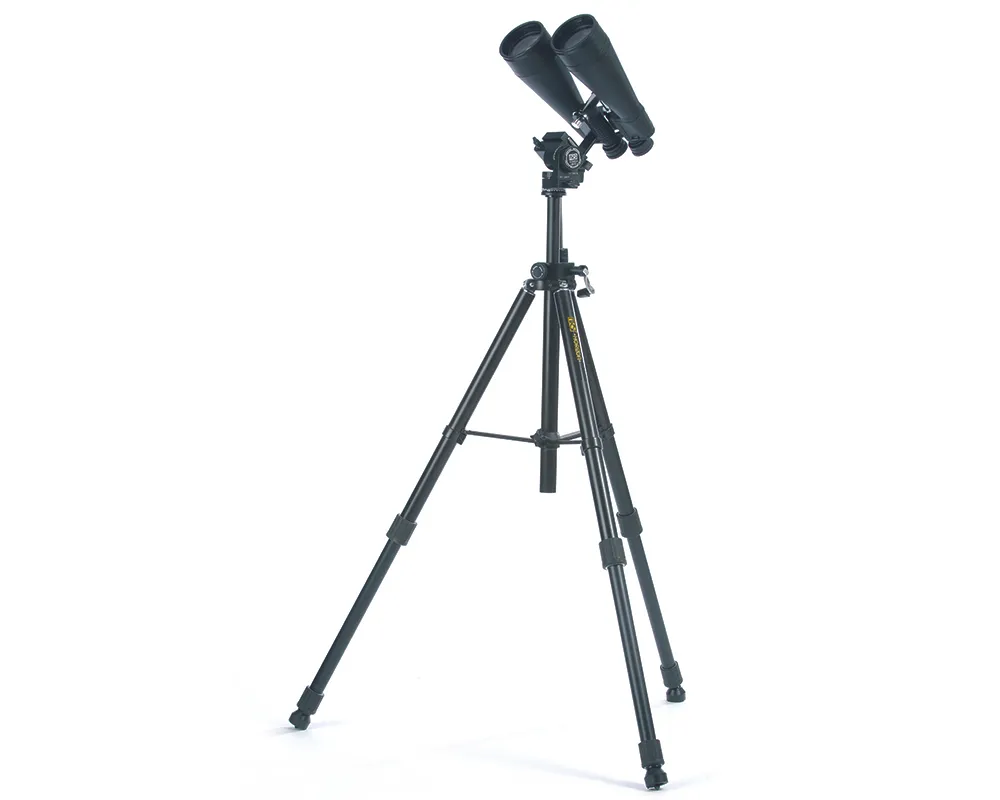
- Buy now from Amazon
The Horizon Heavy Duty tripod is advertised on its packaging as ideal for video and photo purposes, but it proved to be equally suitable for observing with our hefty Celestron 20x80 SkyMasters, which weigh 3kg.
It is a nicely constructed three-part black aluminium tube tripod with good solid rubber leg-locks defining the height. It comes equipped with a bubble level, leg spreader and a pleasingly smooth altazimuth mount.
The height of the mount above the tripod is adjusted using a ratcheted shaft; in use it proved a little jerky sometimes, but it does provide the height needed for those over 6ft (1.82m) tall.
On the plus side, the plate onto which the binoculars or adaptor plate fit is well designed.It is held in place by a sprung locking mechanism that has to be slid prior to release.
So, when used in its most comfortable arrangement, with the altitude adjustment arm pointing away, the binoculars could not easily fall off even if the spring failed – very reassuring.
Because of the tripod’s design, looking at anything within 15° of the zenith was difficult and caused some uncomfortable neck strain.
Still, it’s a nice, lightweight (3.5kg) tripod to use with binoculars, and it’s certainly affordably priced.
Manfrotto Tripod
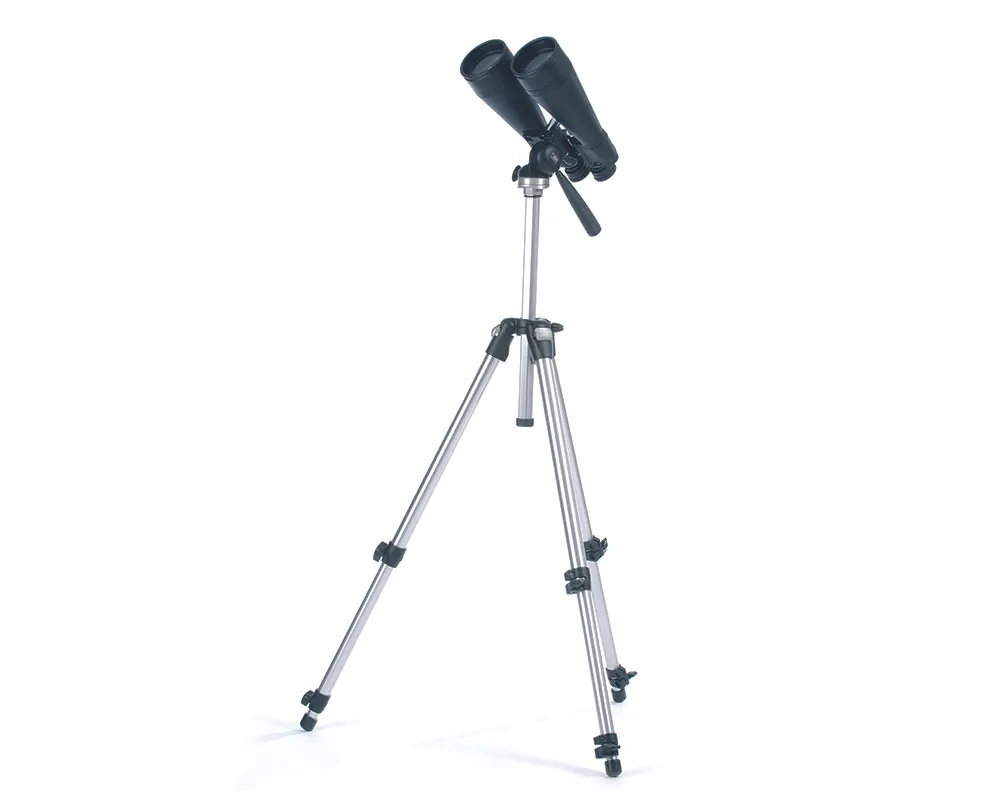
- Buy Manfrotto mounts from Curry's
- Buy Manfrotto mounts from Wex
- Visit Manfrotto.com
For our review we used an Italian Manfrotto tripod topped with a 390RC2 altazimuth mount head.
The leg spread limiter on the Manfrotto is built into the leg/mount joint but, rather surprisingly, this doesn’t seem to have any noticeable negative impact when using the tripod with binoculars.
The three-section uncoated aluminium tube legs with their associated locking knobs proved sturdy enough during the testing.
As you would hope, the tripod is easily set up. The height of the built-in mount above the tripod is changed by undoing the associated knob and then raising it by hand.
Not as elegant an adjustment solution as a ratchet, admittedly, but in use it worked fine.
There was, however, a slight tendency for the altazimuth mount to droop when we attempted to lock it in a given position.
On several occasions we locked the SkyMasters onto a centred high elevation target only to find that the object of interest was now residing toward the bottom of the field of view.
It was a bit frustrating at first, but easily overcome with practice.
That said, the Manfrotto tripod is slightly lighter (3.2kg) than the Horizon tripod, very simple to set up and adjust, and long enough for tall people.
Universal Astronomics T-Mount Light
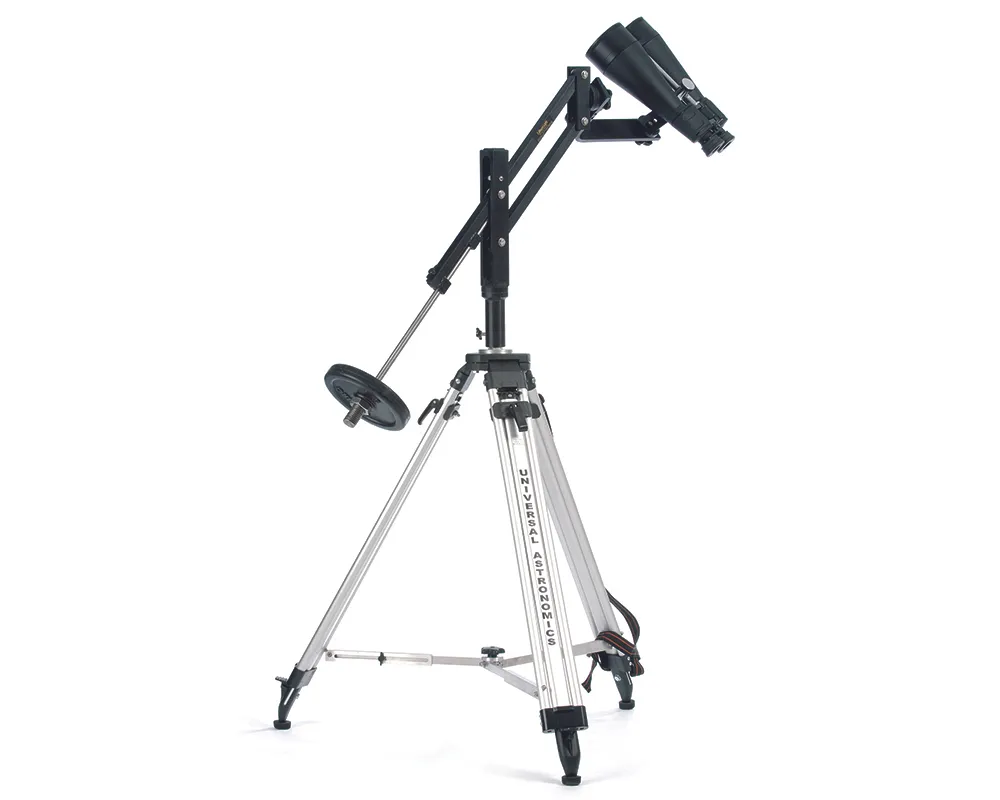
The T-Mount Light is one of two very similar mounts made by Universal Astronomics, the other being the UniMount Light.
They are both solidly constructed from 18mm tubing, but the UniMount has longer parallelogram arms.
Setting up the counterweight arm, we noticed that it was not secured by a fail-safe method.
Its position is adjusted by undoing a securing bolt, sliding the arm and then re-tightening the bolt.
If you forget to re-tighten the bolt, there is nothing to prevent the arm sliding out and falling with the weight to the floor.
Due to the tolerances involved, this would not always happen – even when observing objects high overhead.
That aside, the mount performed well, moving smoothly on the special tripod adaptor.
The longer (508mm) armed UniMount is a better choice for viewing from the relaxed position of a garden recliner.
The adaptor is a very good idea as it means the weight of the binoculars, mount and counterweight is not being supported on a standard camera adaptor bolt.
The tripod is also very impressive, with the leg spread limiter allowing each leg to be more than 1.85m from its neighbour – thus providing a good solid base for the heavier SkyMaster 20x80 binoculars.
In fact, the setup we tested could have gone on to securely hold bigger binoculars than this, like a giant 100mm pair, for example.
ScopeTeknix Binoflex Mirror Mount
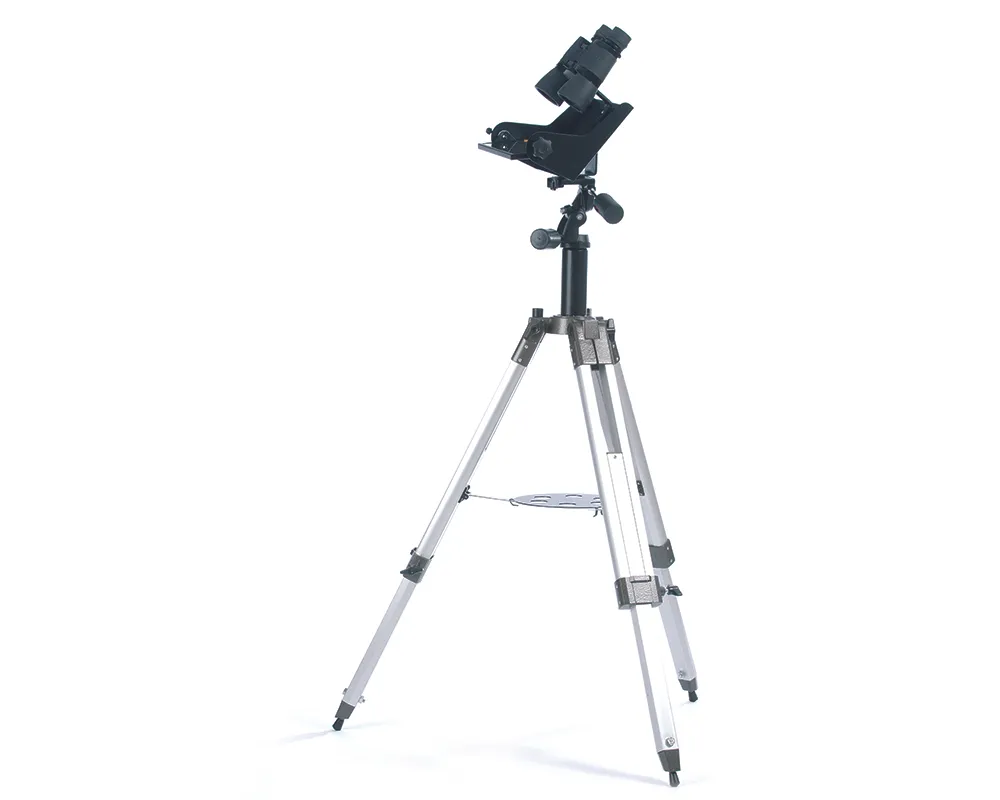
The Binoflex is certainly different from most binocular mounts. You position the tripod so you can sit next to it and look through the mounted binoculars into the tilting mirror.
This allows you to view a swathe of sky roughly 30º wide, from the zenith to the horizon opposite.
Adjustment in altitude is achieved by moving the 99x202mm mirror and in azimuth by rotating the mount on its tripod post.
To see other parts of the sky, you simply move the chair round the tripod.
In use, this somewhat unusual system worked surprisingly well.
Not looking directly at the sky was a little disconcerting at first, especially as the image was upside down, but when observing something overhead it proved to be a great convenience.
The design is well suited to 10x50 binoculars. Image quality is great with the 10x50s, but seemed a little soft with our 20x80s, perhaps due to the mirror flexing slightly.
The Binoflex mount was let down, though, by the supplied Trigant tripod.
The legs are best adjusted prior to assembly, the threads on the locking knobs are of poor quality and the eyepiece tray is pointless.
Fortunately, though, the 2kg mount can be purchased separately from the 4.6kg tripod.
Orion Paragon-Plus Binomount
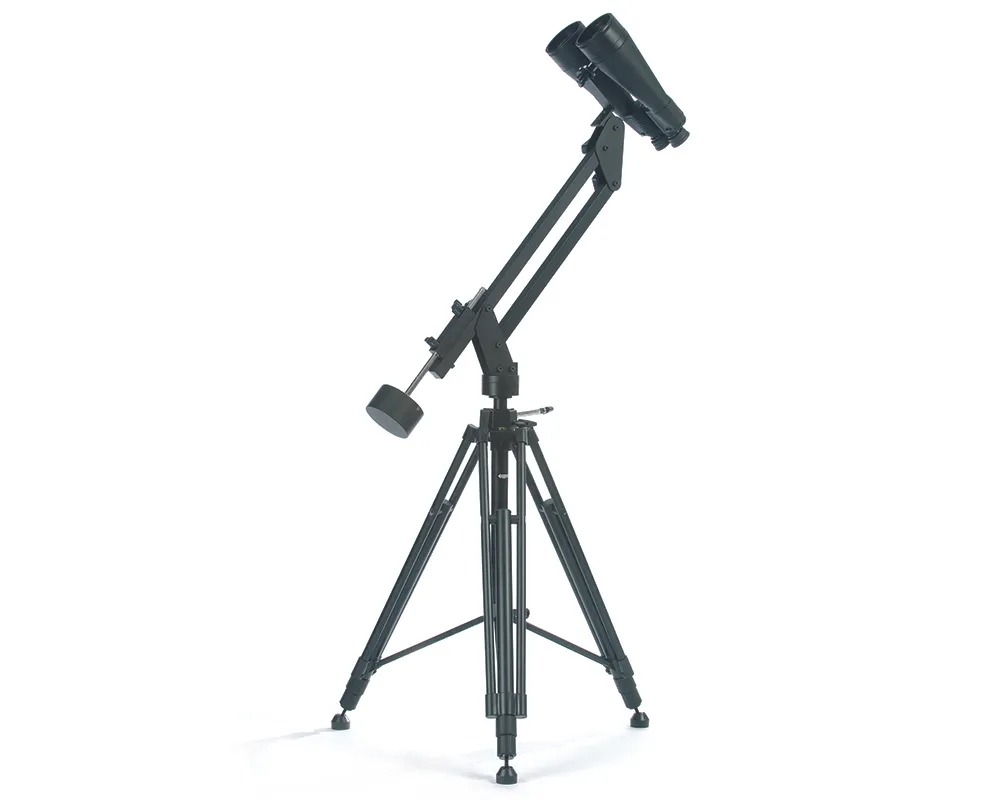
- Buy the Orion Paragon-Plus Binocular Mount and Tripod from Orion Telescopes
- Buy the Orion Paragon-Plus Binocular Mount without Tripod from Orion Telescopes
This is a nice mount. Someone has clearly given some thought to the aesthetics as it is attractively constructed using black 25mm aluminium tubing and black hexagonal bolts.
It boasts arms 433mm long – the shortest of the three parallelogram mounts we tested – and weighs in at 5.5kg.
The movement in azimuth and altitude is very smooth and it is nice to use.
The weight used to balance the mount is on a plated rod, which is locked in place with two bolts and prevented from slipping out by a ring.
The tripod is quite light (3.2kg), solidly built and provides a nice firm base.
Unlike the other tripods covered in our test, the leg length is locked in place using a twisting action, which works well.
The mount height, meanwhile, can be raised using a ratchet on a 25mm shaft.
We feared this would make the mount a little unsteady, but that didn’t prove to be the case in practice, despite the mount being held onto the tripod by a single standard camera mounting thread.
After a little use it was noticeable that the 80mm binoculars probably represented the maximum weight the supplied counterweight could effectively balance.
Some lightweight 100mm binoculars might work, but it would be as well to assume a different counterweight will be necessary.
Whether that’s a problem will obviously depend on what binoculars you’re using. Otherwise, this is a fine set up.
Epsilon Parallelogram Mount
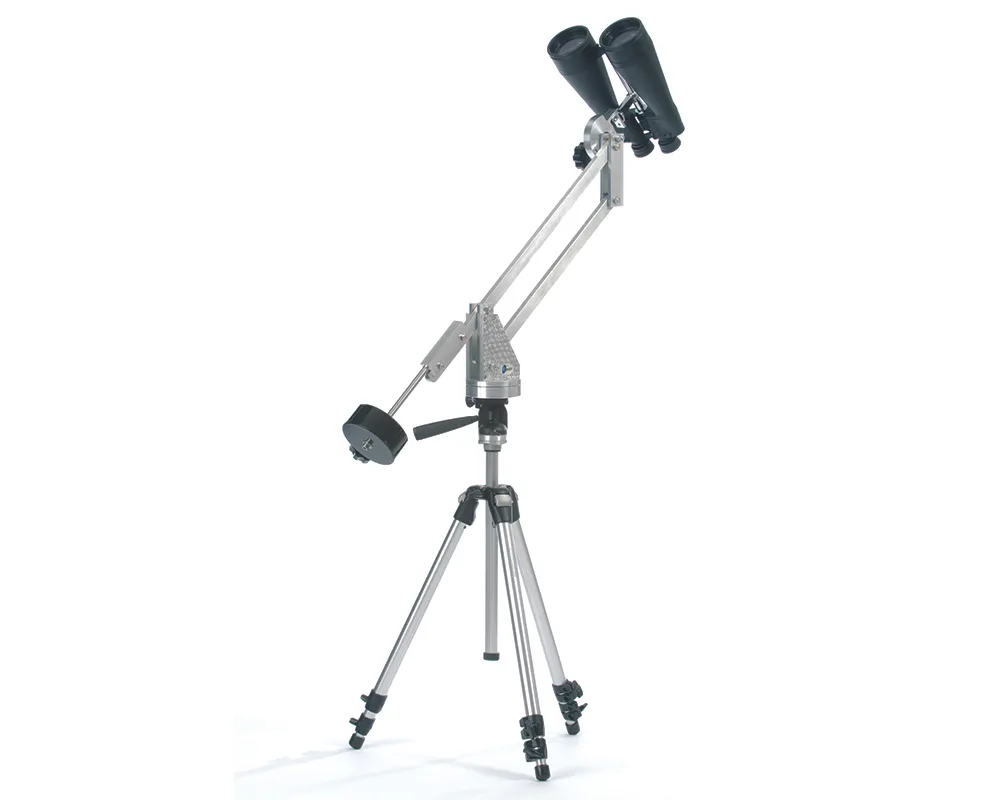
After testing the black tube-based parallelogram mounts, the Epsilon was certainly a change of style.
The arm construction (10x25mm) is extremely robust, with solid metal parts employed throughout and the matt finish of the two previous mounts rejected in favour of a metallic sheen.
With arms 483mm long, the mount is a good compromise between what is best for viewing when standing as well as reclining.
Inevitably, there is a downside to the extra weight and that became apparent when setting up and transporting the mount.
At a mount weight of 8.5kg we would suggest a good solid tripod needs to be used with it.
This might be a bit on the heavy side for lugging back and forth to observation sites, especially for retired observers.
No tripod was supplied with the mount we examined but it was seen that, in common with the Orion, the means of securing the mount to the tripod was a standard camera fitting.
Currently the mount is made to order, but that will be changing shortly.
In use, the mount moved very smoothly both in elevation and azimuth, and was easily adjusted.
One slightly worry was that at some elevations the bars that make up the parallelogram can close up sufficiently that they might crimp fingers a little (though this problem can be overcome with a strategically placed rubber spacer).
That niggle aside, this mount is a pleasure to use and a nicely finished piece of kit.
10Micron BM100 Leonardo mount

The Leonardo parallelogram mount is clearly a rigidly constructed and well-finished product.
The locking pin means there's no finger-trapping parallelogram movement during use, and also helps when attaching the binoculars and counterweights.
You'll need a substantial tripod or pier, although it's purposely designed for the 10Micron/Geoptik range of tripods. Pre-drilled holes allow it to be used with other heavy-duty options.
You can lock the parallelogram horizontally when you fit binoculars and counterweights and gradually slacken the friction to achieve balance.
The Leonardo parallelogram is a joy to use. It operates smoothly and there are ‘warm-touch’ handles and knobs where you would want them.
Read our full Celestron SkyMaster Pro 20×80 and 10Micron BM100 Leonardo mount review.
Orion Monster Parallelogram mount
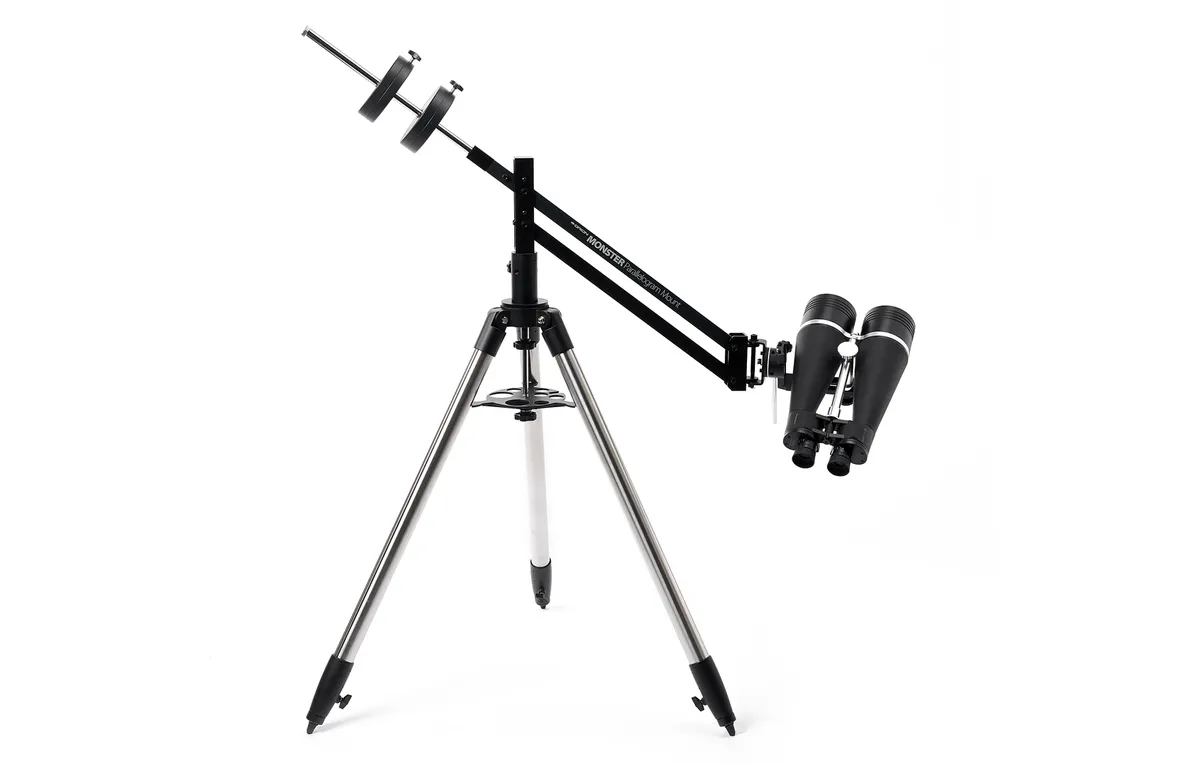
Orion’s Monster Parallelogram mount has some nice touches, such as the ability to vertically adjust the mounting bracket in order to achieve balance.
This enables the user to achieve that ‘floating binocular’ effect that's a sign of a good parallelogram mount.
The tripod is a Synta-made model with 1.75-inch diameter legs, and a north pin to prevent the parallelogram from unscrewing itself.
There are two counterweights and you can experiment with their positions to achieve a short vibration-damping time.
Read our full Orion Monster Parallelogram mount, GiantView 25×100 binoculars review.
Celestron SkyMaster 20 x 80 Binocular with Star 75 Camera Tripod

- Buy now from Amazon
This all-in-one package offers a pair of 20x80 SkyMaster binoculars from Celestron, a Star 75 tripod to mount them on and a carrying bag for transporting the whole setup to dark-sky sites.
You will need a tripod mounting adapter for porro binoculars, but you can pick up good quality adapters fairly cheaply online.
The tripod features rubber feet to help avoid slippage, a quick-release clamp for when you need to quickly change your mounted device, a spirit level for achieving balance and a height-adjustable centre column.
